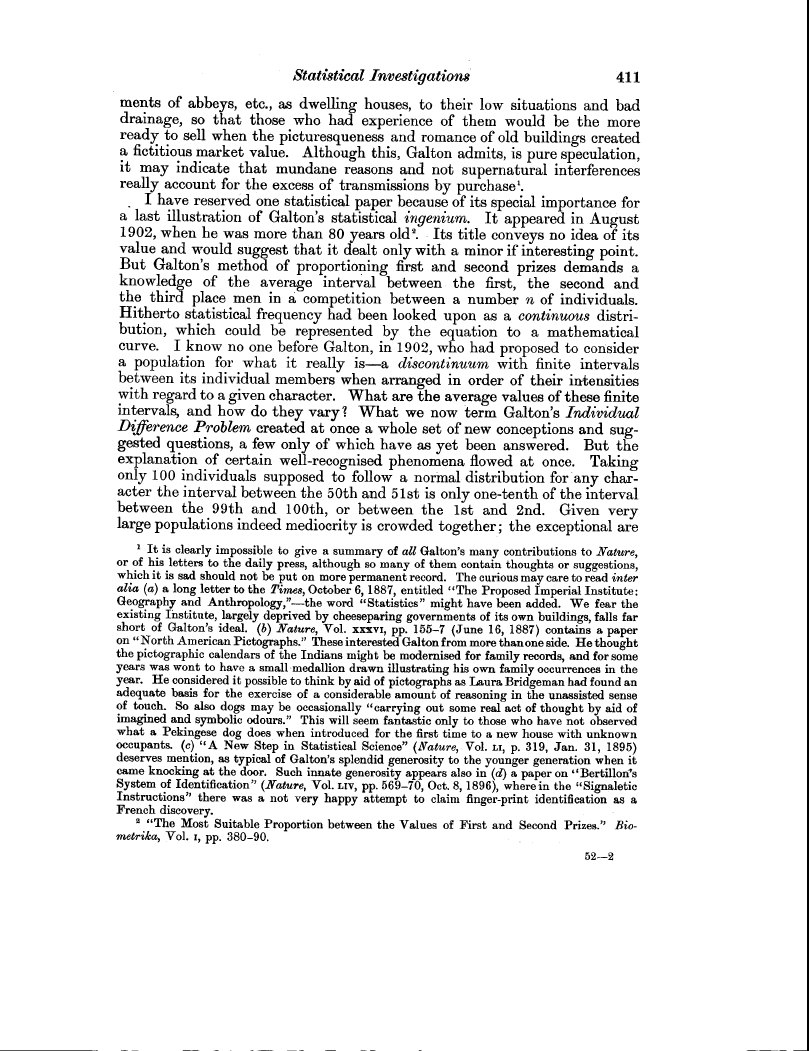Statistical Investigations 411
ments of abbeys, etc., as dwelling houses, to their low situations and bad drainage, so that those who had experience of them would be the more ready to sell when the picturesqueness and romance of old buildings created a fictitious market value. Although this, Galton admits, is pure speculation, it may indicate that mundane reasons and not supernatural interferences really account for the excess of transmissions by purchase'.
I have reserved one statistical paper because of its special importance for a last illustration of Galton's statistical ingenium. It appeared in August 1902, when he was more than 80 years old'. Its title conveys no idea of its value and would suggest that it dealt only with a minor if interesting point. But Galton's method of proportioning first and second prizes demands a knowledge of the average interval between the first, the second and the third place men in a competition between a number n of individuals. Hitherto statistical frequency had been looked upon as a continuous distribution, which could be represented by the equation to a mathematical curve. I know no one before Galton, in 1902, who had proposed to consider a population for what it really is-a discontinuum with finite intervals between its individual members when arranged in order of their intensities with regard to a given character. What are the average values of these finite intervals, and how do they vary? What we now term Galton's Individual Difference Problem created at once a whole set of new conceptions and suggested questions, a few only of which have as yet been answered. But the explanation of certain well-recognised phenomena flowed at once. Taking only 100 individuals supposed to follow a normal distribution for any character the interval between the 50th and 51st is only one-tenth of the interval between the 99th and 100th, or between the 1st and 2nd. Given very large populations indeed mediocrity is crowded together; the exceptional are
' It is clearly impossible to give a summary of all Galton's many contributions to Nature, or of his letters to the daily press, although so many of them contain thoughts or suggestions, which it is sad should not be put on more permanent record. The curious may care to read inter alia (a) a long letter to the Times, October 6, 1887, entitled °'The Proposed Imperial Institute: Geography and Anthropology,"-the word "Statistics" might have been added. We fear the existing Institute, largely deprived by cheeseparing governments of its own buildings, falls far short of Galton's ideal. (b) Nature, Vol. xxxvi, pp. 155-7 (June 16, 1887) contains a paper on" North American Pictographs." These interested Galton from more thanone side. He thought the pictographic calendars of the Indians might be modernised for family records, and for some years was wont to have a small medallion drawn illustrating his own family occurrences in the year. He considered it possible to think by aid of pictographs as Laura Bridgeman had found an adequate basis for the exercise of a considerable amount of reasoning in the unassisted sense of touch. So also dogs may be occasionally "carrying out some real act of thought by aid of imagined and symbolic odours." This will seem fantastic only to those who have not observed what a Pekingese dog does when introduced for the first time to a new house with unknown occupants. (c) "A New Step in Statistical Science" (Nature, Vol. L1, p. 319, Jan. 31, 1895) deserves mention, as typical of Galton's splendid generosity to the younger generation when it came knocking at the door. Such innate generosity appears also in (d) a paper on I' Bertillon's System of Identification" (Nature, Vol. LIV, pp. 569-70, Oct. 8, 1896), wherein the "Signaletic Instructions" there was a not very happy attempt to claim finger-print identification as a French discovery.
z "The Most Suitable Proportion between the Values of First and Second Prizes." Biometrika, Vol. i, pp. 380-90.
52-2

